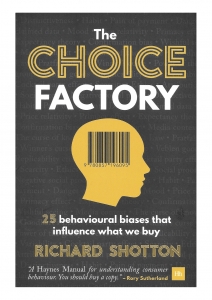The one sentence summary
There are at least 25 behavioural biases that influence what we buy.
WHAT THE BOOK SAYS 
- The Fundamental Attribution Error. Those in a rush are distracted, so brands need to target contexts as much as audiences.
- Social Proof. Popular brands become even more popular because their visibility provides social proof. Don’t assume your scale is known.
- Negative Social Proof. Don’t confirm inferiority (“Only a tiny proportion of our readers give.”) Flip the statistics in your favour.
- When the world zigs, zag. Subvert category norms.
- Most behaviour is habitual, so aim to shake people out of such behaviour, and target them after they have undergone a life event.
- The Pain of Payment. Handing over money hurts. People using cash overestimate their spend by 9%, so invest in cashless payment technology, and remove the £ signs from your price lists.
- The Danger of Claimed Data. People lie in research, or at least can’t be accurate. Be prepared for deceit and design surveys accordingly.
- Mood. Target customers when they are likely to be happy, and match the message to their mood.
- Price Relativity. Make your brand appear better value by changing the comparison set. Introduce a higher end line to set a new comparison level.
- Primacy Effect. First impressions shape subsequent experiences, so make yours as strong as possible.
- Expectancy Theory. Expectations of a product shape its performance. Good copywriting is therefore like a china plate. It makes products taste better.
- Confirmation Bias. Don’t target those likely or unlikely to buy regardless of communications. Go for those for whom it might make a difference.
- Overconfidence. This affects marketers and customers alike. If you have an above average campaign, leave it alone.
- Wishful Seeing. What we see is sometimes what we want to see. Don’t assume that a brand purpose will solve your marketing problems.
- Media Context. The placement of an ad affects its interpretation.
- The Curse of Knowledge. We struggle to empathise because we are not very good listeners. You need to think like a customer.
- Goodhart’s Law. States that when a measure becomes a target, it ceases to be a good measure.
- The Pratfall Effect. Someone who stumbles or is clumsy is more appealing because they become more approachable. Flaws make brands more appealing.
- Winner’s Curse. Payday spend spikes by 70%. Advertisers often overpay because they outbid others.
- The Power of the Group. Targeting groups boosts effectiveness. It’s like canned laughter – groups respond more than individuals.
- Veblen Goods*. High price can boost demand, counter to what economists would predict. And promotions are like bad cholesterol.
- The Replicability Crisis. Much market research doesn’t generate the same results when done again, so don’t take a single study as definitive proof. Be sceptical, but not cynical.
- Variability. A bias that works in one situation might backfire in another, so using nudges is a constant work of refinement.
- Cocktail Party Effect. You tend to hear your own name mentioned at a loud party – that’s the power of personalisation, and the media landscape is like a packed pub. Think “Your country needs you” rather than “The British army is short of 2 million new recruits.”
- Scarcity. The less there is, the more people want it, so restricting the number of items can boost sales.
*Named after the American economist who identified the phenomenon, although the book doesn’t mention this.
